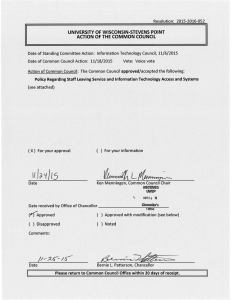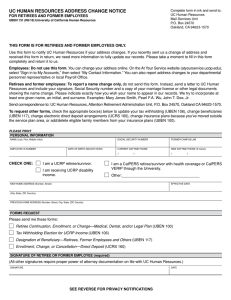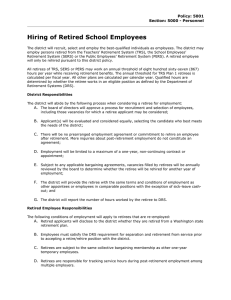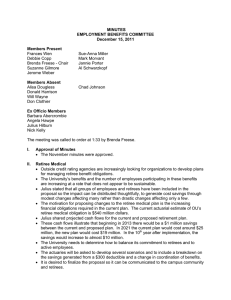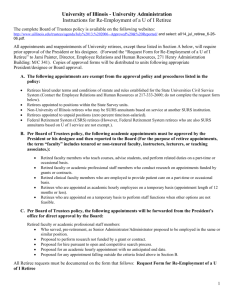(Draft) Proposal for A Retiree Centre for Simon Fraser University
advertisement
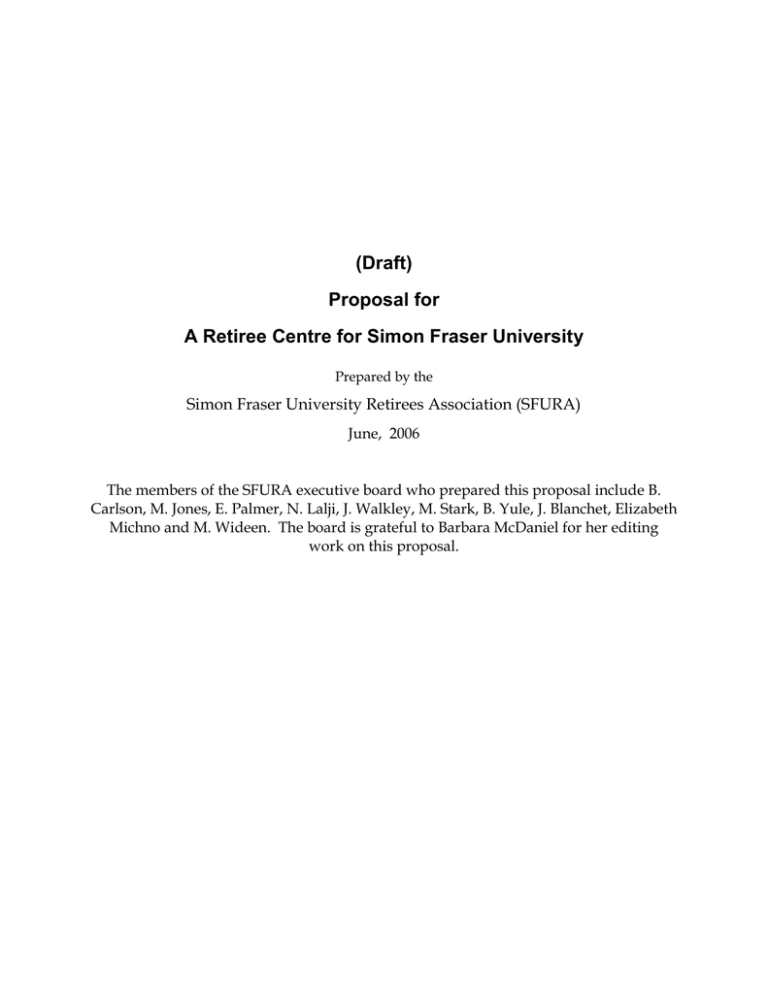
(Draft) Proposal for A Retiree Centre for Simon Fraser University Prepared by the Simon Fraser University Retirees Association (SFURA) June, 2006 The members of the SFURA executive board who prepared this proposal include B. Carlson, M. Jones, E. Palmer, N. Lalji, J. Walkley, M. Stark, B. Yule, J. Blanchet, Elizabeth Michno and M. Wideen. The board is grateful to Barbara McDaniel for her editing work on this proposal. FROM: Simon Fraser University Retirees Association (SFURA) Executive1 2 SUBJECT: A Proposal for a Retiree Centre for Simon Fraser University INTRODUCTION A recent survey of members of the Simon Fraser University Retirees Association disclosed problems that we believe the SFURA should address. In particular, many retirees feel the sort of alienation expressed by this comment: Retirees are literally discarded on retirement and the university loses access to a great resource. While some connections currently exist for retirees, and while several retirees work extensively in some departments, the lack of specific programs and a specific location within which to interact limits a retiree’s ability to remain connected. The University of Toronto and at least eight universities in the United States have established retiree centres to maintain connections with retired faculty, staff, and administrators and their spouses. In turn, the universities are benefiting from the contributions retirees are able to make through the centres. After studying numerous reports and documents about these centres and visiting the centre at the University of Washington, the executive of the SFURA believes such a centre at SFU would cultivate connections with retirees and allow retirees to offer substantial services to SFU. We therefore propose that a retiree centre be established at the Burnaby campus. OBJECTIVES The retiree centre for Simon Fraser University would pursue the following objectives: 1. Facilitate an ongoing connection between retirees and the university. 2. Enable the university to draw upon the considerable talents and abilities offered by retired staff, administrators, faculty and their spouses. 3. Provide an advocacy for and support service to all retired persons and those contemplating retirement. The members of the SFURA executive who prepared this proposal include B. Carlson, M. Jones, E. Palmer, N. Lalji, J. Walkley, M. Stark, B. Yule, J. Blanchet, Elizabeth Michno and M. Wideen. 2 The authors are grateful to Barbara McDaniel for her editing work on this proposal. 1 2 4. Offer opportunities for the university and the retirement group to extend the university community. The growing seniors' age group carries potentially serious social problems if social attitudes do not change. Objective three recognizes the need for support and advocacy for retirees on both an individual and a group level. Persons in the retiree centre could work with researchers and people interested in social issues to alert policy makers, insurance companies and other agencies to problems affecting retired persons. The fourth objective sees the retiree centre adding a new dimension to the university. Signifying SFU as vibrant and progressive, the centre's role in fund-raising, courses, and research and development would enhance the university's profile in the larger social and academic communities. ACTIVITIES The centre would provide an infrastructure for programs involving retirees, and would work out policies and practices. It would offer programs like those described below. 1. A volunteer/mentorship program. In a volunteer program for retirees and their spouses, activities could range from hosting international visitors to helping students get started in their university work. Retirees could mentor students, staff, administrators and beginning faculty. An example of successful mentoring from outside the University is the RCMP Victim Services Program: volunteers provide services to victims of crime. 2. Teaching, consulting and research. The centre could enable retirees to engage in research, international consulting and teaching (full time or as guest lecturers). People might continue their previous research after they retire or participate in research on issues that affect seniors. The centre could also support retirees in their applications for research. 3. Specific projects. The centre could work on projects like the oral history DVD project recently completed, and it could act as a welcoming centre for donors during fund-raising events. 4. Support and advocacy. By working with other groups on campus, such as the Gerontology Research Centre, and with off-campus groups, persons in the centre could contribute to the investigation of ways to study and support retired persons. 3 5. SFURA activities. Current SFURA activities like those offered through the social programs and the seminar series could continue within the new framework of the centre. 4 STRUCTURE There are a number of ways the centre could be structured within the university. It could be organized within a department such as Human Resources, an academic Department, or a Faculty. It could be built around an organization such as the Faculty Association, SFURA, the Burnaby Mountain College, or some combination of those and others. Or it could be independent, planned around SFURA or entirely separate from the university. An example is the centre at the University of Washington, which is a virtually independent body linked to the Provost's office. Any type of centre at SFU could build on existing activities and practices of SFURA and individual retirees. SFURA now shares some limited space to hold meetings and house files. It offers its 350 members and spouses a rich program of social activities, and presents seminars for members and the university community. Several retirees provide considerable voluntary service to the university. SFURA is supported financially by membership fees and an annual grant from the president’s office. Whatever the structure, we firmly believe that a retiree centre established on the SFU campus must reflect an underlying SFURA principle: staff, administrators and faculty are equal partners in the organization. We add the caveat that the objectives, activities, and structures proposed above would be discussed in the ongoing negotiations of a collaborative process. SPACE The proposed centre requires space on the campus in which to carry out its activities. The location should make it possible for the centre to welcome retirees and visitors to the campus. The centre needs office space, a staff, study space and access to a seminar room. The office should have room to house files and accommodate support persons. The site should be attractive and preferably have windows and be on the ground floor. IMPLEMENTATION Glazer (2005) points out that the key factors determining the success of campus centres include a strong commitment from the central administration, adequate funding to support a professional and administrative team, and sufficient resources to communicate with an off-campus constituency. Staff and executives at the retirement centre at the University of Washington have also stressed the importance of support from the central administration of the university. 5 Assuming that these conditions prevail, we propose an implementation process with three stages. 1. First steps. At the earliest possible date, the university would make available to SFURA the services of a part-time clerical worker and temporary space large enough to accommodate the work of planning, developing programs, and raising funds to support programs. 2. Planning and initiation. The university administration would establish a broadly based steering committee to review the options available within the university and to set out a plan for the retiree centre. Meanwhile, SFURA, using volunteers from SFURA and elsewhere in the university, would plan and initiate various programs in consultation with the steering committee. 3. A permanent centre. When a permanent retiree centre has been established, programs that are underway and volunteers already in place will make a smooth transition to the new facility. By this time, issues regarding governance and structure will have been resolved through discourse among campus groups led by the steering committee. Select Bibliography Cusack, S. and W. Thompson. 1998. Leadership for Older Adults. Philadelphia: Taylor Francis Group. Delany, P. 2005. "Retirement and the College Model." Paper presented to the CURAC Conference, Vancouver, April 2005. Dougherty, P. 2006. washington.edu/admin/uwra. Glazer, S. 2005. "University Retiree Centers in the United States." Presentation made to the CURAC Conference, Vancouver, May 2005. Glazer, S., E. Redmon and K. Robinson. 2005. "Continuing the Connection: Emeriti/Retiree Centers on Campus." Educational Gerontology 31:363-383. Grima, L., D. Creelman, R. Garber and R. Stone. 2005. "U of T Retiree Centre: A Proposal." Toronto: Retired academics & Librarians of the University of Toronto. Hindes, N. 1990. The Retirement Association at the University of Washington: A History. Seattle: University of Washington Press. 6 Warkentin, G. 2005. "Establishing Retiree Engagement: Inside the Process." Presentation made to the CURAC Conference, Vancouver, May 2005. SFURA PLAN OF ACTION 1. Continue to survey literature and web sites on retiree centres. 2. Interview, conduct focus groups, and survey SFURA members regarding the concept and its application. 3. Survey the work now being done by retirees on campus. 4. Continue discussions with the President and the university administration. 5. Circulate the proposal to, and meet with representatives from the Burnaby Mountain College, Faculty Association, CUPE, and other groups. 6. Revise the proposal for final presentation to the President and the university administration. 7

